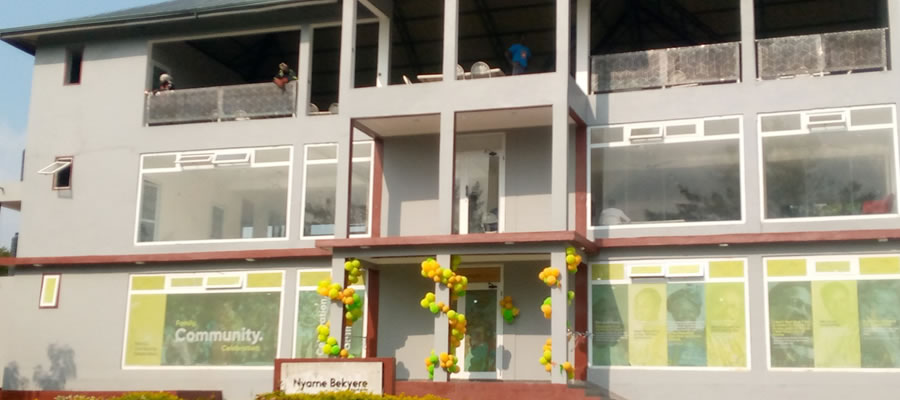

Agriculture activities in the Municipality seem to be dwindling. The sector was previously the main backbone of the Municipality that employ about 60% of the population but now, only 37.4% of the economically active population is engaged in this sector. This reduction can be attributed to challenges such as loss of agriculture lands to real estate or construction, inadequate agriculture extension services, erratic rainfalls, inadequate credit facilities to farmers, inadequate storage facilities, high prices of farm inputs and post-harvest losses in the farms making the sector less lucrative.
Types of Agriculture Activities
The agricultural system practiced in the Municipality is largely subsistence farming with just a few engaged in commercial scale farming for. Activities within this sector include crops farming, livestock rearing, tree planting and fishing farming.
Crop Farming
Crop farming is mainly done in the rural areas of the Municipality. The main crops cultivated are cassava, plantain, cocoyam, maize, cabbage, palm nuts, cocoa, and oranges. Cassava is the most predominant crop cultivated in the Municipality, followed by palm fruits/nuts and it is mostly cultivated in areas such as Kwamoso, Korkorm and Ankoani respectively. Mangoase is also an area noted for the cultivation of vegetables such as cabbages, pepper, okra, tomatoes and garden eggs. Fruits such as oranges, pineapples, and pawpaw are also cultivated in the Municipality.
Livestock Farming
Livestock commonly reared in the Municipality are poultry birds and ruminants. There are three systems used in keeping livestock in the Municipality. These are intensive, semi-intensive and free range. The areas of livestock farming in the Municipality are Tutu, Obosomase, and Mampong. The only challenge faced in this sub-sector is the non-formation of associations and groups which would have made it more productive, vibrant and strong.
Fish farming
Fish farming is the least farming activity in the Municipality. It has only 13 agricultural households engaged in it. Thus seven (7) households in the urban areas and 6 in the rural areas.
Food security
Agriculture is the main occupation of majority of people in the Municipality. It can therefore be said that Agriculture generally plays a vital role in economic development in the municipality. A sound food security situation impacts positively on the development of the area in the sense that the limited resources are not channeled into providing relief services but rather into development. The Municipality has adequate food distribution outlets. On a whole, there are twenty five (25) food distribution outlets.
There is one major market that operates on biweekly basis to ensure increased access to food all year round. In addition, there are also smaller markets located in almost all major towns and communities in the Municipality. There is however, the issue of inadequate storage facilities for storing food during the bumper seasons hence making a lot of farm produce to go waste. Even though there are small scale agro-processing enterprises they are also inadequate in number. There is therefore the need to encourage more youths in MSEs into agro-processing under the Rural Enterprise Programme (REP).
Nutrition Security
To ensure food security and promote good nutrition, the following interventions were implemented: instituted measures to prevent post-harvest losses; promoted the production and utilization of locally grown and nutrient-rich (protein fortified) food; strengthened early warning and emergency preparedness systems; developed and implemented a nutrition strategy, which adopted a life-cycle approach to reduce malnutrition at all levels; eliminated child and adult overweight and obesity; and promoted research and development in food and nutrition security (FNS). In the Akuapem North Municipality malnutrition in children under 5years is 0.4percent with Adawso recording the highest (0.7%) and Akropong being the lowest (0%) as shown in table 1.10 below. However, anaemia in pregnant mothers is high recording 19.2percent at antenatal registration and 17percent at 36weeks of pregnancy getting into time of delivery.
Land
The Municipality is endowed with vast land. The land area of the Municipality is 450 square kilometers representing about two point three percent (2.3%) of the entire land mass of the Eastern Region. The land supports agricultural, quarrying and sand winning activities which are sources of income to households especially the rural households. Though the Municipality has a vast land, the lands are mostly undulating in nature and therefore characterized by hills and valleys. However, down the ridge from Saforo through Kwamoso to Okrakwadwo, the land of about 4500 acres is fairly flat and has supported activities like agriculture, real estate development, establishment of industrial parks such as business incubators and other industries, etc.
Date Created : 11/23/2017 1:23:19 AM













 facebook
facebook
 twitter
twitter
 Youtube
Youtube
 +233 593 831 280
+233 593 831 280 0800 430 430
0800 430 430 GPS: GE-231-4383
GPS: GE-231-4383 info@ghanadistricts.com
info@ghanadistricts.com Box GP1044, Accra, Ghana
Box GP1044, Accra, Ghana